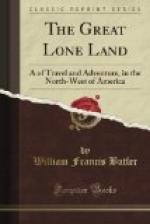The aboriginal inhabitants of the country lying between Red River and the Rocky Monntains are divided into tribes of Salteaux, Swampies, Crees, Assineboines, or Stonies of the Plains, Blackfeet and Assineboines of the Mountains. A simpler classification, and one which will be found more useful when estimating the relative habits of these tribes, is to divide them into two great classes of Trairie Indians and Thickwood Indians—the first comprising the Blackfeet with their kindred tribes of Bloods, Lurcees, and Peagins, as also the Crees of the Saskatchewan and the Assineboines of the Qu’Appelle; and the last being composed of the Rocky Mountain Stonies, the Swampy Crees, and the Salteaux of the country lying between Manitoba and Fort Ellice. This classification marks in reality the distinctive characteristics of the Western Indians. On the one hand, we find the Prairie tribes subsisting almost entirely upon the buffalo, assembling together in large camps, acknowledging the leadership and authority of men conspicuous by their abilities in war or in the chase, and carrying on a perpetual state\of warfare with the other Indians of the plains. On the other hand, we find the Indians of the woods subsisting by fishing and by the pursuit of moose and deer, living together in small parties, admitting only a very nominal authority on the part of one man, professing to entertain hostile feelings towards certain races, but rarely developing such feelings into positive hostilities—altogether a much more peacefully disposed people, because less exposed to the dangerous influence of large assemblies.
Commencing with the Salteaux, I find that they extend westward from Portage-la-Prairie to Fort Ellice, and from thence north to Fort Pelly and the neighbourhood of Fort-a-la-Corne, where they border and mix with the kindred race of Swampy or Muskego Crees. At Portage-la-Prairie and in the vicinity of Fort Ellice a few Sioux have appeared since the outbreak in Minnesota and Dakota in 1862. It is probable that the number of this tribe on British territory will annually increase with the prosecution of railroad enterprise and settlement in the northern portion of the United States. At present, however, the Sioux are strangers at Fort Ellice, and have not yet assumed those rights of proprietorship which other tribes, longer resident, arrogate to themselves. The Salteaux, who inhabit the country lying west of Manitoba, partake partly of the character of Thickwood, and partly of Prairie Indians—the buffalo no longer exists in that portion of the country, the Indian camps are small, and the authority of the chief merely nominal. The language spoken by this tribe is the same dialect of the Algonquin tongue which is used in the Lac-la-Pluie District and throughout the greater portion of the settlement.




